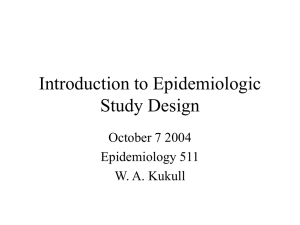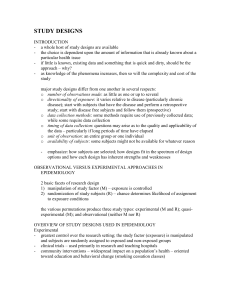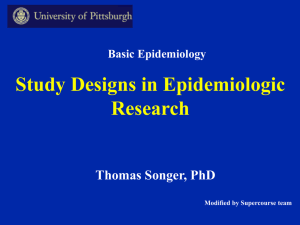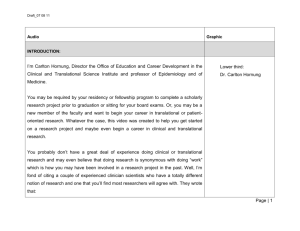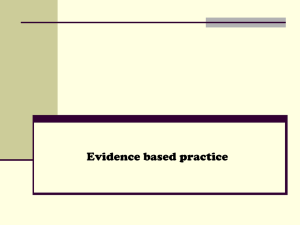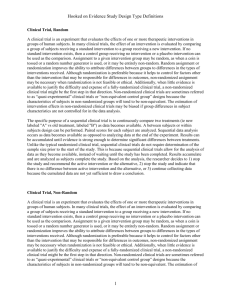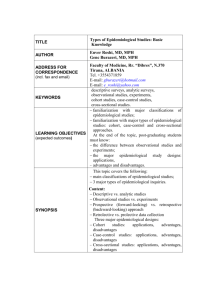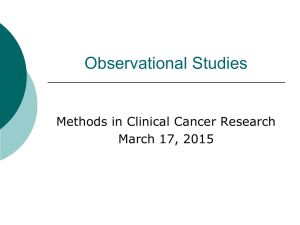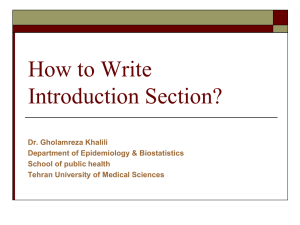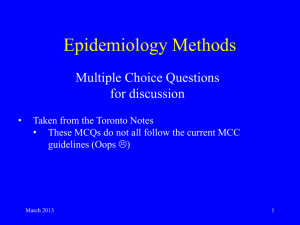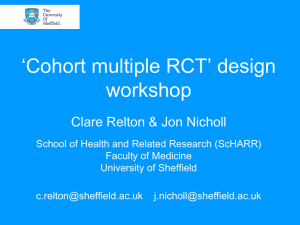Clinical Study: Design and methods
advertisement
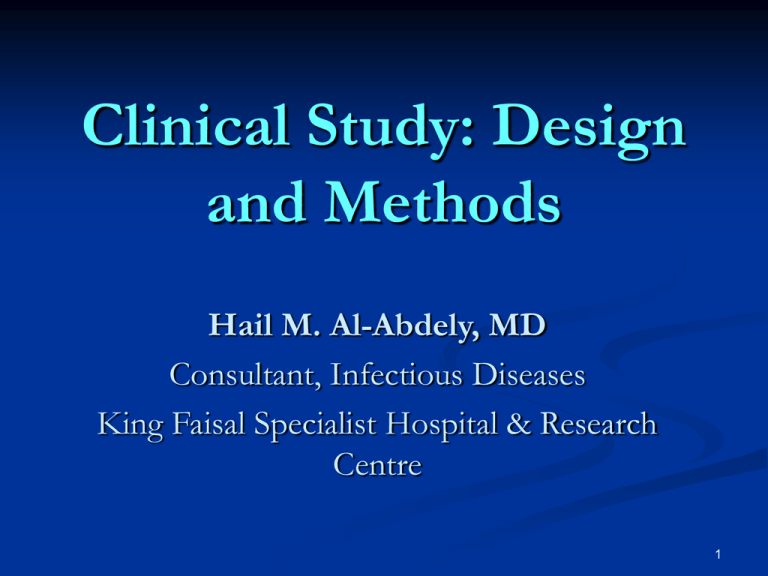
Clinical Study: Design and Methods Hail M. Al-Abdely, MD Consultant, Infectious Diseases King Faisal Specialist Hospital & Research Centre 1 Definitions of Research “Systematic investigation towards increasing the sum of knowledge” (Chambers 20th Century Dictionary) “an endeavour to discover new or collate old facts etc. by the scientific study of a subject or by a course of critical investigation.” (The Concise Oxford Dictionary) 2 Where to Start? A good clinical study starts with a good question based on good hypothesis that is based on good and comprehensive review of the available evidence from pre-clinical and clinical data Type of design depends on the question to be answered 3 Formulating a Research Question Focused and specific What is the prevalence of Hepatitis B surface Antigen in Saudi Arabia? What are the risk factors for hepatitis B infection? Prospective cohort or case- Is interferon a useful therapy for hepatitis B infection? Therapeutic clinical trial Is vancomycin better than ceftazidime against gram negative organisms? Not a replication of already established evidence control Supported by available data Cross-sectional study Is smoking associated with lung cancer? Ethical Answerable Methods, resources ….etc 4 Objectives Specific aims Clear and detailed End point(s) Primary The main answer to the research question Secondary Answer other related questions 5 Study Design Your question Your resources Describe Analyze Retrospective Prospective Community Acceptance of research Observational Interventional 6 Clinical Study Types Observational Studies Cohort (Incidence, Longitudinal) Case-Control Cross-Sectional (Prevalence) Case Series Case Report Experimental Studies Uncontrolled Trials Controlled Trials 7 Levels of Evidence Hierarchy of Strength of Evidence for Treatment Decisions Level I: Level I (A): Level I (B): Level II (A): Level II (B): Level III: Level IV: N of 1 randomized trial (double-blinded, cross-over) Systematic reviews of randomized trials Single randomized trial Systematic review of observational studies addressing patient-important outcome Single observational study addressing important outcome Physiologic studies Unsystematic clinical observations (case-reports, anecdotal) JAMA 2000; 284(10):1290-96 8 Observational study Clinical trial describe as occurring in nature observational study exposed outcome allocate randomly non exposed Clinical Trial Ethics! 9 Important issues in Study Design Validity: Truth External Validity: Internal Validity: Can the study be generalized to the population Results will not be due to chance, bias or confounding factors Symmetry Principle: Groups are similar 10 Important issues in Study Design Confounding: distortion of the effect of one risk factor by the presence of another Bias: Any effect from design, execution, & interpretation that shifts or influences results Confounding bias: failure to account for the effect of one or more variables that are not distributed equally Measurement bias: measurement methods differ between groups Sampling (selection) bias: design and execution errors in sampling 11 Introduction Why this study is needed ? What is the purpose of this study? Was purpose known before the study? What has been done before and how does this study differ? inadequacies of earlier work or next step in an overall research project Does the location of the study have relevance? 12 Why doing a study? Alternative: census: test every individual in the population use available data, e.g. hospitals But: - data availability - data quality - cost - questions require specific type of data and circumstances 13 Types of observational studies CROSS - SECTIONAL STUDY COHORT STUDY CASE CONTROL STUDY CASE SERIES/CASE REPORTS 14 Characteristics of observational studies No control over study units need to clearly describe study individuals Can study risk factors that have serious consequences Study individuals in their natural environment (>> extrapolation) Possibility of confounding 15 Aims of observational studies Evaluate the effect of a suspected risk factor (exposure) on an outcome (e.g. disease) define ‘exposure’ and ‘disease’ Describe the impact of the risk factor on the frequency of disease in a population 16 Cross - Sectional Study 17 Cross - Sectional Study (1) Exposure and disease measured once, i.e. at the same point in time n exposed ? diseased ? past present future 18 Cross - Sectional Study (2) Random sample from population i.e. results reflect reference population Estimates the frequencies of both exposure and outcome in the population Measuring both exposure and outcome at one point in time Typically a survey 19 Cross - Sectional Study (3) Can study several exposure factors and outcomes simultaneously Determines disease prevalence Helpful in public health administration & planning Quick Low cost (e.g. mail survey) Limitation: Does not determine causal relationship Not appropriate if either exposure or outcome is rare 20 Pediatricians per 1000 Children Cross-Sectional: Pediatrician-to-Child Ratio 40 35 30 25 20 15 10 5 0 1981 1986 1991 1996 Rural Urban Greg et al. (2001) Pediatrics.107(2):e18 21 Cross-Sectional: Risk Factors for Smoking Variable No. friends who smoke: - all vs. none of them - most vs. none of them - about half vs. none of them - a few vs. none of them Any siblings who smoke: Y vs. N OR 95% CI 36.5 18.4 7.5 2.1 2.8 9.3 – 142.8 5.5 – 61.8 2.2 – 26.0 0.6 – 7.9 1.8 – 4.3 Mother smokes: Yes vs. No Have no mother vs No 1.9 3.5 1.3 – 2.9 0.8 – 15.0 22 Cohort Studies 23 Cohort studies Follow-up studies; subjects selected on presence or absence of exposure & absence of disease at one point in time. Disease is then assessed for all subjects at another point in time. Typically prospective but can be retrospective, depending on temporal relationship between study initiation & occurrence of disease. 24 Cohort Study (1) Individuals selected by exposure status and future occurrence of disease measured n n Exposed yes no past disease ? yes Exposed disease ? no present disease ? disease ? future 25 Cohort studies (2) More clearly established temporal sequence between exposure & disease Allows direct measurement of incidence Examines multiple effects of a single exposure (nurses’ health study, OC and breast, ovarioan cancers) 26 Cohort studies (3) Limitations: time consuming and expensive loss to follow-up & unavailability of data potential confounding factors inefficient for rare diseases 27 Prospective Cohort Study with outcome Exposed without outcome Cohort with outcome Unexposed Onset of study without outcome Time Direction of inquiry Q: What will happen? 28 Prospective Cohort Study Appropriate for frequent disease Can examine only few risk factors Usually expensive RR = ‘relative risk’ = incidence rate ratio AR = incidence difference 29 Case-Control Studies 30 Case-Control Study (1) Retrospective First identify cases Then identify suitable controls Can use hospital or health register data Hardest part: who is suitable ?? Then inquire or retrieve previous exposure By interview By databases (e.g. hospital, health insurance) 31 Case-Control Study (2) Diseased and non-diseased individuals are selected first Then past exposure status is retrieved n exposed ? exposed ? past yes disease no present future 32 Case-Control Study (3) Good for rare disease (e.g. cancer) Can study many risk factors at the same time Usually low cost Confounding likely OR (not RR !!) 33 Case-Control Study Design Exposed Cases Unexposed Exposed Controls Unexposed Data collection Time Direction of inquiry Q: What happened? 34 Case-Control study (4) • • • • • Study subjects selected on basis of whether they have (case) or do not have (control) a disease Useful for disease with long latency period Efficient in terms of time & costs Particularly suited for rare diseases Examines multiple exposures to a single disease 35 Case-control study (5) Limitations: (1) susceptible to bias (particularly selection & recall) (2) difficulties in selection of controls (3) ascertainment of disease & exposure status (4) inefficient for rare exposures unless attributable risk is high 36 Case Selection • Define source population • Cases – incident/prevalent – diagnostic criteria (sensitivity + specificity) • Controls – selected from same population as cases – select independent of exposure status 37 Control Selection • Random selection from source population • Hospital based controls: – convenient selection – controls from variety of diagnostic groups other than case diagnosis – avoid selection of diagnoses related to particular risk factors – limit number of diagnoses in individuals 38 Summary of Observational Studies Characteristic Sampling Time Causality Frequency measure Risk parameter Cross Sectional Case Control Cohort Random sample: Purposive sample: population diseased/nondiseased One point Retrospective Statistical Screening for association many risk factors Prevalence None Purposive sample: Exposed/nonexposed Prospective Testing one (or few) risk factors Incidence Prevalence (risk) Odds ratio ratio, odds ratio Relative risk, odds ratio 39 Clinical Trials 40 Clinical Trials – Drug Development Basic Research In-Vitro Screening In-Vivo Screening Isolated cells & tissues Drug Licensing & Release Clinical Trials I - III Safety Testing In Humans 41 In Animals Novel Compounds Clinical trials in drug development (Any alternatives) In-Vitro Tests Can Show Whether: • A compound has the desired effect on isolated cells or tissues • There are adverse effects on those tissues • In-Vitro Tests Cannot Show Whether: • The desired effect will occur in a complete living system • There will be any adverse effects in a complete living system 42 Clinical trials in drug development (Any alternatives) Animal Tests Can: Suggest which drugs are likely to be effective in humans Indicate which drugs may not be harmful in humans Animal Tests Cannot: Predict with absolute certainty what will happen in humans 43 Clinical trial vs. Cross-sectional Clinical trial: Individuals selected by entry condition Control over exposure Exposure groups fully comparable Outcome measured after allocating individuals to exposure Therefore: causal association likely Cross Sectional Study: Individuals selected randomly Exposure observed as occurring in nature (groups not ‘identical’) Exposure AND outcome measured at one point in time No causal interpretation 44 Clinical Trials-Phases Phase I - Does it hurt the Patient? Phase II - Does it help the Patient? On patients to confirm the effectiveness of the drug Phase III - Is it any better? Usually in normal volunteers, small groups for safety testing Large groups of patients for statistical confirmation of effect and incidence of side-effects Phase IV - Does it work in the community? Post marketing studies. Fine tuning and new rare findings from a very large population 45 Clinical Trial: Study Design Uncontrolled Controlled Before/after (cross-over) Historical Concurrent, not randomized Randomized 46 Non-randomized Trials May Be Appropriate • Early studies of new and untried therapies • Uncontrolled early phase studies where the standard is relatively ineffective • Investigations which cannot be done within the current climate of controversy • Truly dramatic response 47 Advantages of Randomized Control Clinical Trial 1. Randomization "tends" to produce comparable groups 2. Assure causal relationship 3. Randomization produces valid statistical tests 48 Disadvantages of Randomized Control Clinical Trial 1. Generalizable Results? Participants studied may not represent general study population. 2. Recruitment Hard 3. Acceptability of Randomization Process Some physicians will refuse Some participants will refuse 4. Administrative Complexity 49 Clinical Protocol (1) Background/Justification --Where we are in the field --What the study will add that is important Objectives --Primary hypothesis --Secondary hypotheses --Other 50 Study Population Subset of the general population determined by the eligibility criteria General population Eligibility criteria Study population Enrollment Study sample Observed 51 Clinical Protocol (2) Study Design and Methods Type of study, comparison Inclusion and exclusion criteria Description of intervention (what, how) Concomitant therapy Examination procedures (baseline, follow-up, outcome assessment) Intervention assignment procedure Data collection sheet Informed consent 52 Eligibility Criteria (inclusion & exclusion) State in advance Consider Potential for effect of intervention Ability to detect that effect Safety Ability for informed consent 53 Method Outlines (1) The independent (predictor) and dependent (outcome) variables in the study should be clearly identified, defined, and Measured? How to choose subjects? Random or not Are they going to be representative of the population? Random selection is not random assignment Types of Blinding (Masking) Single, Double, Triple. Control group? How is it chosen? How are patients followed up? Who are the dropouts? How is the data quality insured? Reliability? Consider independent review of data? Compliance? 54 Methods outlines (2) Reference any unusual methods? Statistical methods specified in sufficient details Is there a statement about sample size issues or statistical power? ? multicenter study. Quality assurance measures should be employed to obtain consistency across sites? 55 Comparing Treatments • Fundamental principle • Groups must be alike in all important aspects and only differ in the intervention each group receives • In practical terms, “comparable treatment groups” means “alike on the average” • Randomization • Each participant has the same chance of receiving any of the interventions under study • Allocation is carried out using a chance mechanism so that neither the participant nor the investigator will know in advance which will be assigned • Blinding • Avoidance of conscious or subconscious influence • Fair evaluation of outcomes 56 Patients and Clinicians Kept Blind To Treatment? Investigator Care taker 57 Methods outlines (3) Monitoring and Management --Data and safety monitoring --Adverse event assessment, reporting --Contingency procedures --Withdrawal criteria 58 Regular Follow-up Routine Procedures (report forms) Interviews Examinations Laboratory Tests Adverse Event Detection/Reporting Quality Assurance 59 Compliance/adherence Pill counts and computers Diaries Biological tests 60 Lipid lowering drugs after myocardial infarction Mortality clofibrate 18.2% placebo 19.4% Overall Clofibrate 18.2% Clofibrate Adherence 80 < 80% 15.0% 24.6% 61 Methods outlines (4) Statistics --Sample size --Stopping guidelines --Analysis plans Participant protection issues 62 Sample Size The study is an experiment in people Need enough participants to answer the question Should not enroll more than needed to answer the question Sample size is an estimate, using guidelines and assumptions 63 Contingency Plans Patient management Evaluation and reporting to all relevant persons and groups Data monitoring plans Protocol amendment or study termination 64 Human Subjects Protection • • • • • • • Institutional Review Board Informed consent Different levels of risk Confidentiality as well as risk of new tx Patient can refuse to participate w/o effect Path to exit study known Compensation 65 Summary Selection of design should be made on the basis of the particular hypothesis to be tested with consideration of current state of knowledge Consider available resources when deciding on a study design A clear and organized study design leads to successful results Observational studies are especially valuable in epidemiology Clinical trials carry the highest level of evidence and should be pursued whenever feasible 66

